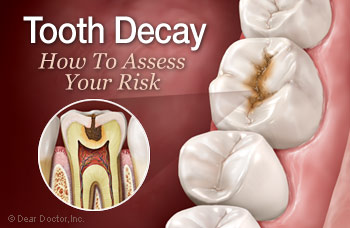In a previous introductory article on dental caries (tooth decay), we discussed both the causes of the disease process along with new strategies to promote health (“Tooth Decay — The World's Oldest & Most Widespread Disease,”). Now we'll discuss Caries Management By Risk Assessment (CAMBRA) — the latest way to minimize risk and prevent decay.
Modern dentistry is moving towards an approach to tooth decay management that is evidence-based — meaning it is based on years of systematic, accumulated, and valid scientific research. In other words, using current science, your dental treatment is tailored to your actual risk rather than a “one size fits all” approach. The previous method of “drilling and filling” to treat decay does not change the conditions that lead to the disease in the first place, so that the risk for further infection still remains. What follows below are facts you should know to change the conditions that lead to decay!
A New Look At Dental Decay — A Dynamic Infectious Disease Process
To help you understand, think of the mouth as an ecosystem, where living organisms continually interact with every other element within their environment. The teeth are composed of an outer covering of enamel, a highly mineralized and crystalline structure composed mainly of calcium and phosphate. The teeth are bathed in a remarkable fluid — saliva. While it has many functions, one of the most important is its role in maintaining a neutral pH environment or balance between the acids and bases found in your mouth.
Acidity is measured scientifically by the pH scale, which ranges from 1 – 14. A pH value of 1 is extremely acidic while a pH value of 14 is extremely basic. The pH of the mouth is generally 7 – neutral.
The oral environment is loaded with bacteria with some of them having the potential to cause decay. Specific acidogenic (acid producing) bacteria attach themselves to dental plaque, the whitish sticky biofilm that collects and forms on the teeth. When you eat sugars or carbohydrates, these acidogenic bacteria break down the sugars and produce acid as a by-product, which in turn drops the salivary pH. At about pH 5.5, the minerals just below the enamel surfaces of the teeth begin to dissolve in a process known as de-mineralization. During this process, more calcium and phosphate leave the surface of the teeth than enter it — the first step in the decay process leading toward cavity formation. And because a tooth's roots are made of dentin, which is softer than enamel, they are more susceptible to decay. For example, the roots of an exposed tooth will de-mineralize quickly and easily with even weak acids at pH 6.0 – 6.7, which is much closer to neutral.
Why Me? How To Assess Your Risk
Given similar habits, you might wonder why some people get cavities and others don't. Dr. John Featherstone, an imminent researcher studying the effects of all these different factors, introduced the concept of the Caries Balance in 2002, in which he demonstrated that both the disease, dental caries, and dental health are a delicate balance between pathologic (disease causing) and protective (health promoting) factors. This dilemma can be further explained by understanding that individuals have their own unique balance, similar to a playground's seesaw that is constantly changing. The challenges are to identify what is out of balance and how to tip it towards health and protection.
It's Sort Of Like...
A great analogy is likening caries risk assessment to how a physician assesses risk for cardiovascular (“cardio” – heart; “vascular” – blood vessel) disease. The physician reviews your health history, takes your blood pressure, monitors your heart, and provides a treatment plan that may include prescription medications to reduce or manage risk. If your blood pressure is high, it doesn't indicate that you have had a heart attack or stroke or that you definitely will one day. However, it does mean that you are at higher risk for having a heart attack or stroke and that it would be wise for you to take preventive actions! Some of these include: changing your life-style in terms of diet, exercise, and perhaps medication for lowering your risk.
This same process is precisely what we are doing in dentistry today with the CAMBRA approach. We are providing individualized dental care so that we can minimize your caries risk. In fact, modern dentistry can now evaluate risk factors for dental caries disease and use them to make preventive recommendations with the goal of lowering the risk of tooth decay. And as a result, create more predictable, longer-lasting results for any cosmetic or restorative dental procedures.
- See more at: http://www.deardoctor.com/articles/tooth-decay-risk/#sthash.ChFMD2BL.dp